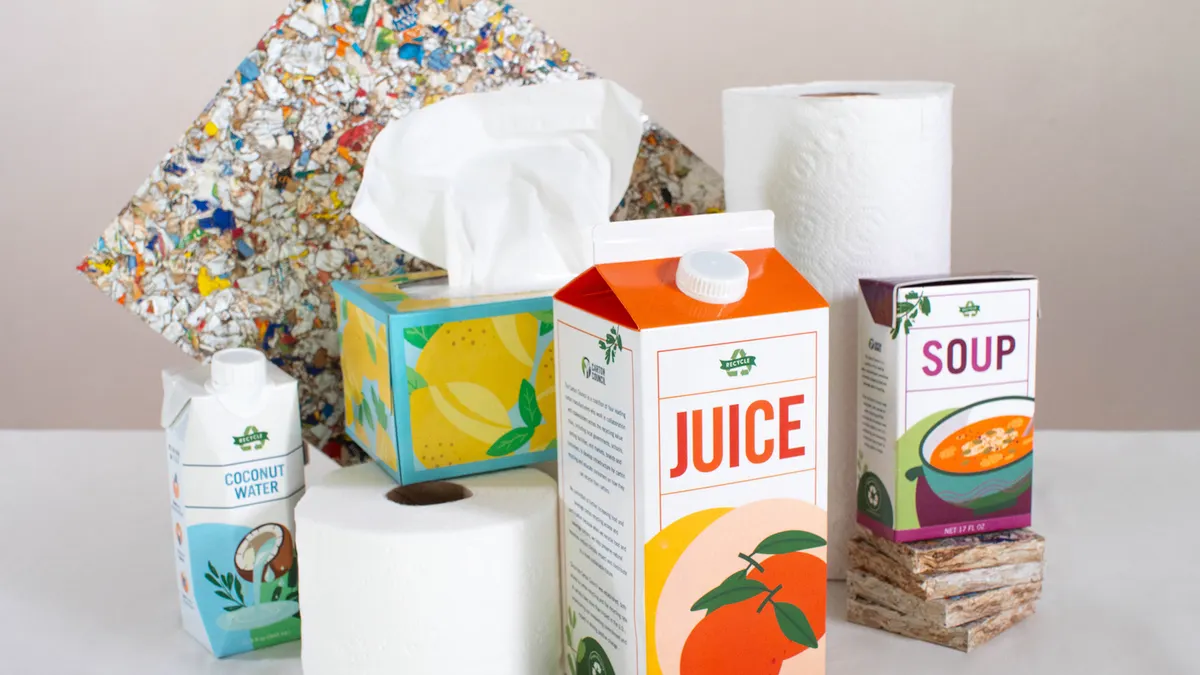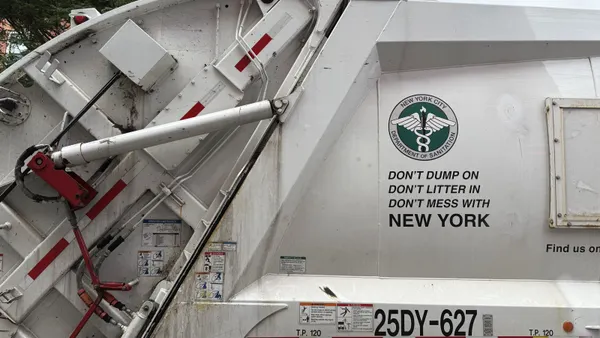Most people know what happens when a food and beverage carton goes into the recycling bin — it is picked up from the curb and taken to a local material recovery facility (MRF). But what happens next?
Once collected, those empty food and beverage cartons move through an expanding network of facilities and manufacturers that turn them into valuable new products.
Carton recycling isn’t just waste diversion. It’s a growing part of the circular economy that keeps materials in use and out of landfills. Some cartons become high-quality fiber for paper goods, while others are transformed into durable building materials that replace virgin resources.
When cartons reach a paper mill, they’re prized for their long, strong fibers. Jason Pelz, VP of Sustainability for Tetra Pak in the U.S. and Canada, says that quality makes them a dependable part of a mill’s feedstock mix.
“Cartons carry some of the best fiber in the recycling stream,” he explains. “At many mills, the yield matches or exceeds other materials.”
While many cartons in the U.S. are pulped to be turned into paper products, there is also a full carton recycling process that allows the fiber, plastic and aluminum to all be recovered.
Inside the mill: A closer look at carton fiber
At Sustana’s mill in De Pere, Wis., recycled cartons provide a steady source of high-quality fiber with strong performance characteristics and brightness suited for premium paper and packaging. Jessica Johnson, the company’s Vice President-Fiber, says the mill recovers up to 60% fiber yield from the cartons it processes. “The yield is lower than that of other paper sources because of the plastics and aluminum,” she says. “But the quality of the recovered fiber makes it a valuable, consistent input.”
Cartons also help mills build supply chain resilience. For example, Johnson says carton fiber diversifies sourcing beyond traditional streams like sorted office paper, which can fluctuate. “We saw it firsthand during the pandemic,” she explains, “when other fiber sources became harder to find, incorporating cartons enabled continuous operations.”
Each recovered carton reduces landfill use, conserves forest resources and keeps high-value fiber in circulation. “Every carton recycled is an opportunity to capture usable fiber,” Johnson says, “all while lowering emissions and strengthening the circular economy.”
How cartons find new life in buildings and everyday products
The paper mill isn’t the only option. Food and beverage cartons are now also being used to manufacture sturdy building boards called EVERBOARD™, which replace virgin gypsum-based materials in roofing systems. Instead of pulping the cartons for fiber, the cartons are shredded and hot-pressed into roof cover board built to last.
“The process is surprisingly simple,” says Jan Rayman, CEO of ReCB LLC. “Food and beverage cartons are shredded into small pieces, spread evenly and then pressed under heat to form large sheets. The heat melts the polymers in the cartons, which naturally bind everything together without added chemicals or water.” The finished boards, typically 4x8 feet, are strong, moisture-resistant and suitable for a variety of building applications.
What began as a niche solution is now being scaled through new recycling facilities known as ReCB LLC. The facilities’ process uses no formaldehyde glues or mining inputs and produces materials with a carbon footprint that’s significantly lower than traditional options.
Their first facility, ReCB Iowa LLC, is operating in Des Moines, Iowa. With support from the Carton Council, they are launching a new plant in Lodi, Calif. Called ReCB California LLC, it is expected to open before the end of 2025 and will turn post-consumer cartons into durable construction boards.
Processing roughly 750 tons of food and beverage cartons each month in California, the facility will add new regional capacity for recycled materials.
Boards made from recycled food and beverage cartons are already being used in large-scale commercial and industrial projects that require durable, low-impact materials.
“We are currently focused on supplying industry-leading commercial roofing manufacturers with a high-performance roof cover board that passes the FM Approvals Very Severe Hail (VSH) Standard and is also, by far, the most sustainable option on the market,” Rayman says. “We’re seeing EVERBOARD™ used in big box stores, warehouses and other large facilities where strength and sustainability both matter.”
Clearing up misconceptions about carton recycling
A common misconception about cartons is that their multi-layer design makes them unrecyclable. Because each package combines paper, plastic and aluminum, many assume the layers can’t be separated or reused. That idea is outdated, Pelz says. “There was a time when recycling cartons was more difficult,” he says. “Technology has since advanced, and recyclers now have processes that separate and recover each layer efficiently. Cartons aren’t a challenge anymore, they’re a resource.”
Improved technology isn’t the only factor driving progress. Over the past decade, carton recycling access in the U.S. has expanded by nearly 240%. Today, food and beverage cartons are widely recyclable in the U.S., with more than 77 million households having access to curbside collection.
Growing end markets for recovered materials, particularly at paper mills and building product manufacturers, reinforce the value of cartons within today’s recycling system.
“Our product, EVERBOARD™, depends on the availability of sorted and baled beverage cartons,” Rayman says. “ReCB LLC has proven that you can take used material originally from one industry and turn it into something long-lasting for another. Truly a win-win.”
Just scratching the surface of carton recycling
Carton recycling collection and end markets continue to evolve, but the potential is clear: both the paper and building materials markets are opening new doors for recovered cartons.
“Our own growth strategy relies on the growing availability of sorted and baled beverage cartons around the country,” Rayman says. “Our whole-carton solution is a mature and dependable end market for this packaging format that is only set to grow in the coming years.”
Paper mills are finding new value in cartons as part of their feedstock mix. With some traditional feedstocks in short supply, cartons offer a reliable substitute. “Some of the materials mills relied on in the past just aren’t as available anymore,” Pelz says. “Cartons provide a steady, high-quality option that keeps production moving and waste out of landfills.”
Pelz encourages recycling operators and municipalities to explore the possibilities of carton recycling. Tetra Pak and the Carton Council offer grants, resources and technical support to help expand access. “If you’re not sure where to start, we can help,” he says. “This is a real opportunity to recover value, strengthen local programs and move the industry forward.”
To learn more about how Tetra Pak supports carton recycling and circular economy growth, visit tetrapak.com.










